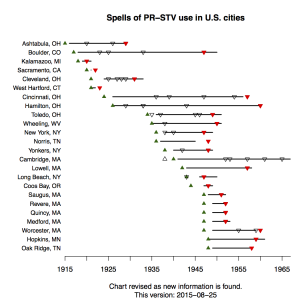If you are reading this, you know that 24 U.S. cities tried the STV form of proportional representation. Here is an updated chart summarizing those episodes.

The changes include:
1) Cropping to 1965, since events thereafter are basically chartjunk.
2) Adding a failed 1959 repeal attempt for Worcester, MA.
3) Changing the dates for Oak Ridge, TN, which evidence suggests to have emerged with STV a decade later than I thought. Note that the Oak Ridge council was “advisory,” whatever that means.
4) Adding Norris, TN, which I had not included because I could not find the dates of any STV elections. This Town Council was also “advisory.” Elections were held annually from 1937 through 1945. I cannot find evidence of an STV election post-1945. The federal government sold Norris to a developer in 1948, and Tennessee granted Norris its own charter in 1949.
5) Date-stamping, since this chart may evolve gain.
Please share any suggested, further changes. Wouldn’t it be nice if our state and local politics were better documented?